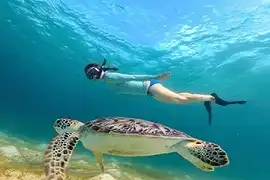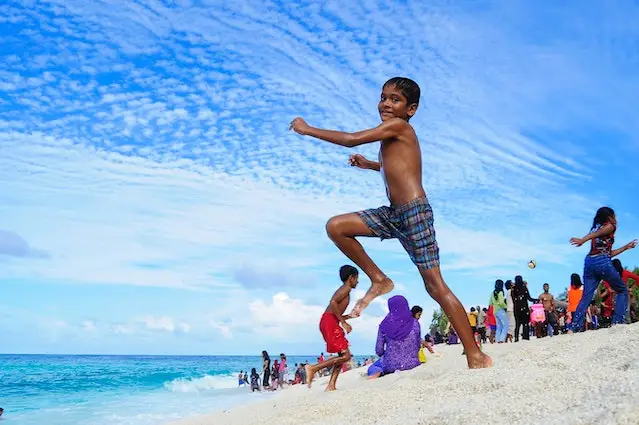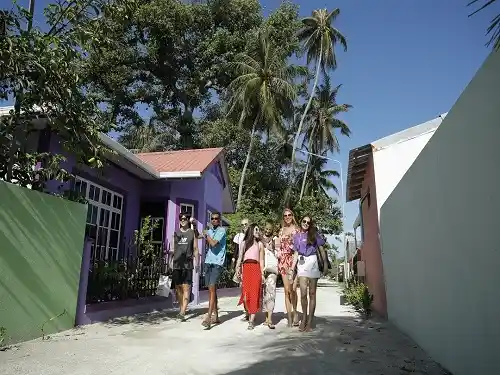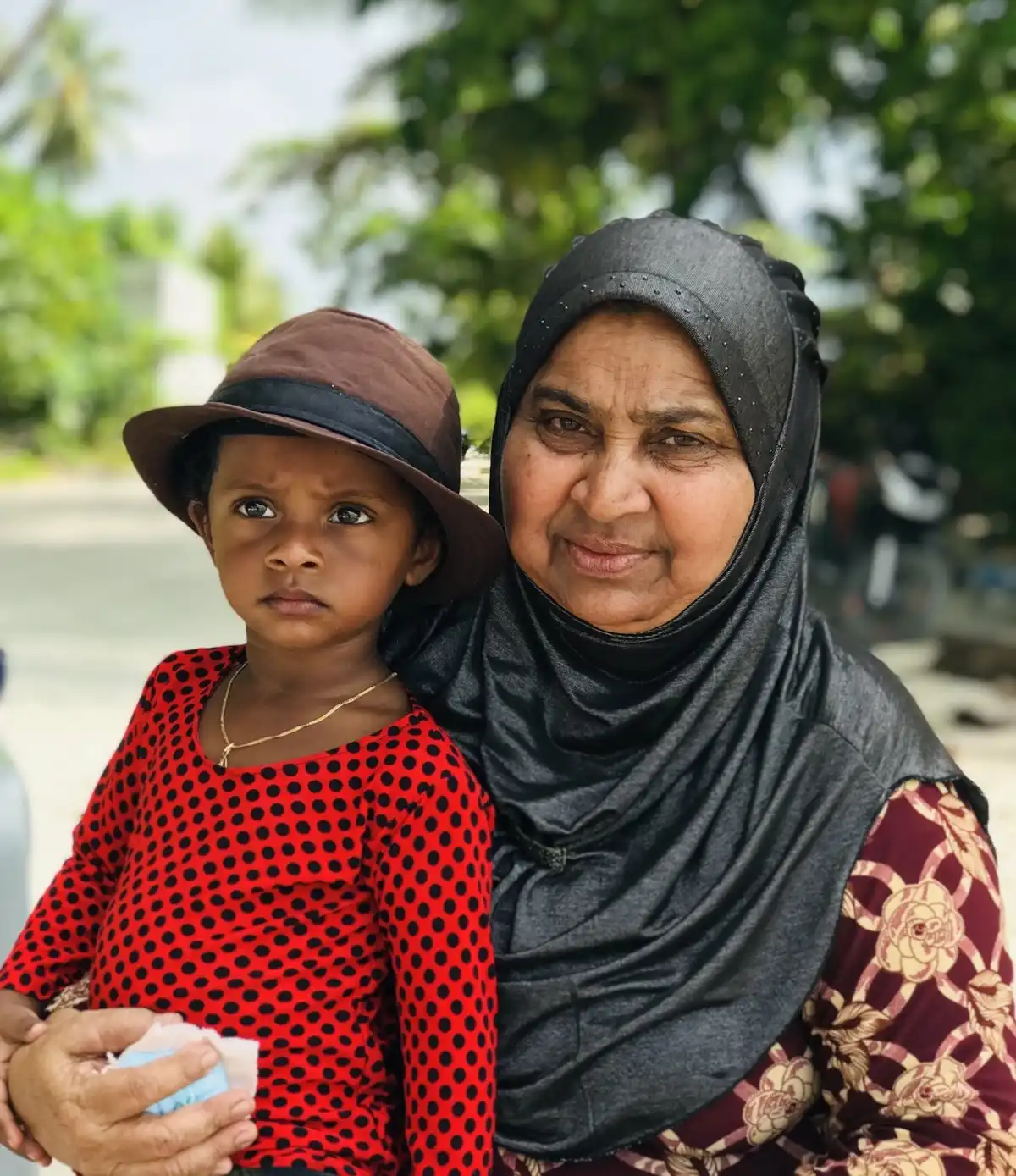Discover a vibrant paradise with marine conservation initiatives, exceptional coral reefs, and authentic Maldivian lifestyle in the remote Gaafu Alifu Atoll
Located in the Gaafu Alifu Atoll in the southern Maldives, Gemanafushi Island offers visitors a rare glimpse into authentic Maldivian island life in one of the country's most pristine and remote regions. This vibrant island maintains its natural beauty and cultural heritage while providing access to some of the Maldives' most untouched marine environments.
What makes Gemanafushi special is its commitment to marine conservation and coral reef protection. The island community has developed several grassroots conservation initiatives aimed at preserving the exceptional marine biodiversity that surrounds the island. These community-led efforts include coral restoration projects, marine protected areas, and educational programs that engage both residents and visitors in protecting the fragile reef ecosystems that are vital to the island's environment and economy.
Visitors to Gemanafushi are drawn by its pristine beaches, exceptional snorkeling and diving opportunities, conservation initiatives, and chances to engage with local community life. The island's remote location in the southern Maldives means fewer tourists and a more authentic experience, while its natural environment offers diverse activities both on land and in the surrounding crystal-clear waters.
Gemanafushi Island is situated in the southern part of the Maldives in Gaafu Alifu Atoll (North Huvadhu Atoll), approximately 400 kilometers south of Male. This remote location in the deeper southern atolls provides a more pristine and less-visited environment compared to islands closer to the capital.
Its position within Gaafu Alifu Atoll offers access to some of the Maldives' most spectacular diving and snorkeling sites, with healthy coral reefs and abundant marine life. The southern atolls are known for their exceptional biodiversity both above and below the water.
Gemanafushi Island stands out among Maldivian islands for its community-led marine conservation initiatives and exceptional coral reef systems, offering visitors a chance to experience and participate in protecting the fragile marine ecosystems that define the Maldives.

Gemanafushi is home to several coral restoration initiatives where damaged reef areas are being rehabilitated through coral nurseries and transplantation efforts, creating new habitats for marine life and strengthening reef resilience.

The island community has established locally managed marine protected areas where fishing and other extractive activities are restricted, allowing marine ecosystems to thrive and providing exceptional snorkeling and diving experiences.

Beyond its conservation areas, Gemanafushi boasts untouched white sand beaches with crystal-clear waters, offering the classic Maldivian beach experience without the crowds found on more developed islands.

Gemanafushi is home to a forward-thinking community that balances traditional island values with environmental stewardship, offering visitors authentic cultural interactions and insights into sustainable island living.
Gemanafushi's marine conservation efforts include several distinctive elements:
These conservation practices make Gemanafushi an ideal destination for travelers interested in experiencing and contributing to marine protection efforts while enjoying the natural beauty that these initiatives help preserve.
The waters around Gemanafushi host exceptional marine biodiversity:
This rich marine biodiversity creates spectacular underwater landscapes and provides visitors with exceptional snorkeling and diving experiences while highlighting the importance of the conservation efforts that help protect these ecosystems.
Gemanafushi offers a growing range of accommodation options that focus on genuine experiences and local hospitality. The island's guesthouses provide comfortable stays while maintaining strong connections to the local community and conservation initiatives.

Several family-operated guesthouses offer clean, comfortable accommodations with environmentally conscious practices. These properties feature air-conditioned rooms with private bathrooms, home-cooked Maldivian meals, and direct access to local knowledge about marine conservation efforts.
Price Range: $50-80 per night
Features: Sustainable operations, conservation information, local excursion arrangements

A few higher-end boutique guesthouses offer enhanced amenities while maintaining an authentic island experience. These properties typically feature more spacious rooms, enhanced dining options, and dedicated facilities for snorkeling and diving activities.
Price Range: $75-120 per night
Features: Higher comfort level, conservation programs, water sports equipment

Several properties offer beachfront locations with direct access to the island's beautiful shores. These accommodations provide stunning ocean views and the soothing sounds of waves, creating a peaceful environment for those seeking proximity to the sea.
Price Range: $70-100 per night
Features: Beach access, ocean views, water sport facilities
Gemanafushi is blessed with pristine beaches and an exceptional marine environment. The island's remote location in the southern atolls and active conservation efforts ensure the surrounding reefs remain in excellent condition, offering fantastic snorkeling and diving experiences.
Gemanafushi features stunning white sand beaches that remain largely untouched by tourism development. The eastern beach is particularly impressive, with powdery sand and crystal-clear turquoise waters that create postcard-perfect vistas. The western side offers a more sheltered environment, with calm waters ideal for swimming.
The island has a designated "bikini beach" where tourists can wear Western-style swimwear. This beautiful stretch of sand provides a relaxing environment while respecting local cultural norms. The remaining beaches require modest dress as they are used by the local community.
Some beach areas are designated as conservation zones, particularly those with turtle nesting sites or adjacent to coral restoration projects. These areas may have special guidelines for visitors to minimize impact on sensitive ecosystems while still allowing for appreciation of their natural beauty.


The waters around Gemanafushi Island offer exceptional marine biodiversity:
Gaafu Alifu Atoll is known for its exceptional marine biodiversity and healthier coral systems compared to some northern atolls, making Gemanafushi an ideal base for underwater exploration and conservation experiences.
Gemanafushi offers a unique blend of conservation experiences and natural adventures. The island's marine protection initiatives provide visitors with opportunities to connect with and contribute to ocean conservation while enjoying its pristine natural environment.











Gemanafushi is home to a close-knit community of approximately 1,200 residents who maintain strong traditional values while embracing environmental stewardship. The island's population is known for its warm hospitality, conservation leadership, and preservation of authentic Maldivian culture.
Daily life on Gemanafushi revolves around the rhythm of fishing activities, conservation work, prayer times, and community gatherings. Mornings often begin with fishermen heading out to sea using sustainable methods, while conservation teams may be monitoring reef health or working on restoration projects. The island awakens with the call to prayer, followed by a day of work, family responsibilities, and community interactions. Many households are involved in some aspect of marine conservation, whether directly participating in projects or supporting initiatives through their businesses. This balanced approach to traditional livelihoods and environmental protection has created a forward-thinking community that values both heritage and sustainability.
Gemanafushi preserves many traditional Maldivian customs and cultural practices. Religious observances play an important role in community life, with festivals like Eid celebrated enthusiastically. Cultural expressions such as Boduberu performances remain vibrant, while traditional crafts and fishing techniques continue to be practiced alongside newer conservation activities. The island's relative isolation in the southern atolls has helped preserve these traditions with less outside influence than islands closer to Male.
What makes Gemanafushi's community special is their pioneering approach to marine conservation. The knowledge of reef ecosystems, conservation techniques, and sustainable resource management has been developed through a combination of traditional ecological knowledge and partnerships with marine scientists. Community members take pride in their role as ocean stewards, with many families actively participating in conservation initiatives. This environmental leadership shapes many aspects of island life, from daily routines to community decision-making, creating a distinctive community identity centered around the relationship between people and the marine environment.


Discover the conservation initiatives, pristine reefs, and genuine island lifestyle of Gemanafushi. Book your stay today for an unforgettable cultural and natural experience in Gaafu Alifu Atoll.
Plan Your TripThe most convenient way to reach Gemanafushi is by domestic flight from Male to Kooddoo Airport (60-70 minutes), followed by a 30-minute speedboat transfer. Due to the island's remote location in the southern atolls, direct public ferry services from Male are limited. Most guesthouses can arrange the complete transfer from Male, including the domestic flight and speedboat connection. When planning your journey, remember that weather conditions can occasionally affect flight schedules in this region, so it's advisable to allow buffer days in your travel plans. The journey to Gemanafushi is part of the adventure, offering beautiful aerial views of the Maldivian atolls during the flight and a chance to experience the stunning blue waters during the speedboat transfer.
Gemanafushi offers several ways for visitors to engage with and contribute to marine conservation efforts. Coral restoration experiences allow participants to learn about and assist with coral nursery maintenance and transplantation projects under the guidance of local conservation teams. Educational snorkeling tours with knowledgeable guides provide insights into reef ecosystems, marine species identification, and conservation challenges while observing the underwater environment firsthand. Beach and reef clean-up activities are regularly organized, giving visitors the opportunity to help remove marine debris and plastics from coastal areas. Marine conservation workshops and presentations offer deeper understanding of local and global marine conservation issues, often led by community conservation leaders. Some guesthouses also offer citizen science opportunities where visitors can help collect data on reef health, marine species populations, or water quality that contributes to ongoing monitoring efforts. The level of involvement can be adjusted based on your interest, time, and experience, from simple observation to active participation. These activities not only provide meaningful experiences but also directly contribute to the community's conservation efforts.
The best time to visit Gemanafushi Island is during the northeast monsoon season (December to April), which brings dry, sunny weather with lower humidity and calmer seas. This period is ideal for water activities, with excellent visibility for snorkeling and diving, often exceeding 30 meters. For those interested in marine conservation activities, this season offers more stable conditions for coral restoration work and reef monitoring. The southwest monsoon (May to November) brings occasional rain showers but also lower prices and fewer tourists. Water temperature remains warm (27-30°C/80-86°F) throughout the year. Due to Gemanafushi's southern location, it may experience slightly different weather patterns than northern atolls, with the possibility of brief rain showers even during the dry season. The shoulder months of November and April often offer a good balance of favorable weather and lower visitor numbers. For specific marine life encounters, different seasons may be preferable - manta rays are more commonly seen during the southwest monsoon when plankton levels are higher, while overall reef visibility is better during the northeast monsoon.
Accommodation on Gemanafushi ranges from simple guesthouses to more comfortable boutique properties, reflecting the island's growing but still authentic tourism development. The island offers several family-run guesthouses that provide clean, comfortable rooms with basic amenities including air conditioning, private bathrooms with hot water, and Wi-Fi (though connectivity may vary). Many accommodations on Gemanafushi have adopted eco-friendly practices such as water conservation, waste reduction, and energy efficiency measures. Some properties specifically market themselves as eco-guesthouses, with features like solar power, rainwater harvesting, or plastic-free operations. Most accommodations offer full-board packages that include three home-cooked Maldivian meals daily, featuring sustainable seafood caught by local fishermen. A few higher-end boutique properties provide enhanced amenities such as more spacious rooms, better furnishings, and additional services while still maintaining an authentic island experience. Several properties are located along the beachfront, offering direct access to the island's beautiful shores. What makes Gemanafushi's accommodations distinctive is their connection to conservation initiatives - many guesthouses actively participate in or support local marine conservation efforts, and some donate a portion of their proceeds to these projects. Visitors should still adjust their expectations to island standards rather than expecting resort-style luxury, embracing the authentic experience and conservation focus that makes staying on Gemanafushi special.
Gemanafushi's marine environment stands out for several reasons that make it particularly special among Maldivian islands. First, its location in the southern Gaafu Alifu Atoll means it benefits from less tourism development and fishing pressure compared to atolls closer to Male, resulting in healthier reef systems with greater coral cover and fish biomass. The community's proactive conservation initiatives have created protected areas where marine life can thrive with minimal human impact, leading to more abundant and diverse ecosystems than on islands without such protections. Coral restoration projects have helped rehabilitate damaged reef areas, creating new habitats and strengthening ecosystem resilience against climate threats. The island's conservation focus has fostered a culture of environmental awareness among both residents and visitors, reducing destructive practices and promoting sustainable interactions with marine environments. Gemanafushi's reefs feature exceptional biodiversity with over 250 coral species and abundant marine life ranging from tiny reef fish to larger pelagic species and sharks. The community's monitoring programs provide ongoing data about reef health, allowing for adaptive management approaches that respond to changing conditions. Educational components integrated into marine activities create more informed and responsible visitors who better understand and appreciate the underwater environment. These factors combine to create a marine experience that not only showcases the natural beauty of Maldivian reefs but also demonstrates how community-led conservation can help preserve these fragile ecosystems for future generations.